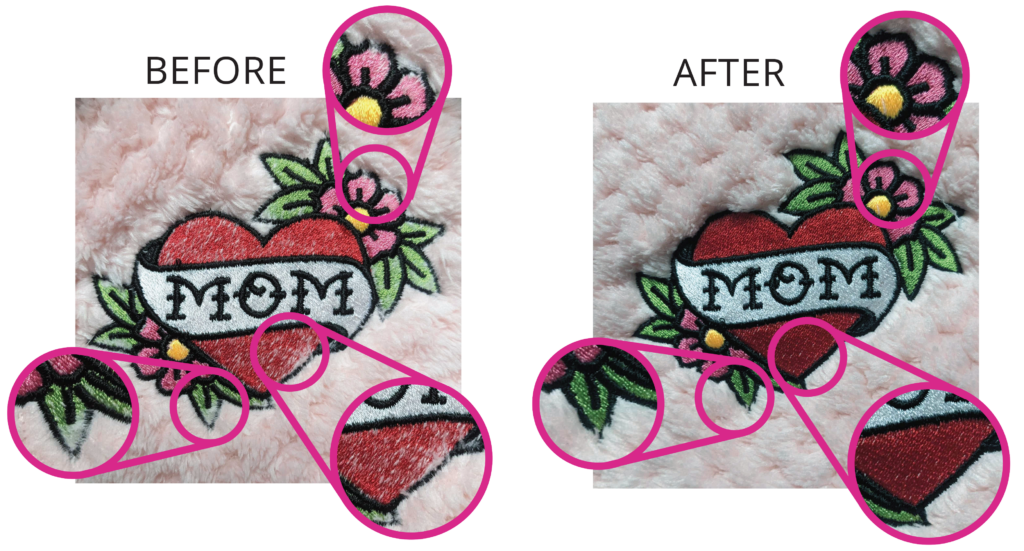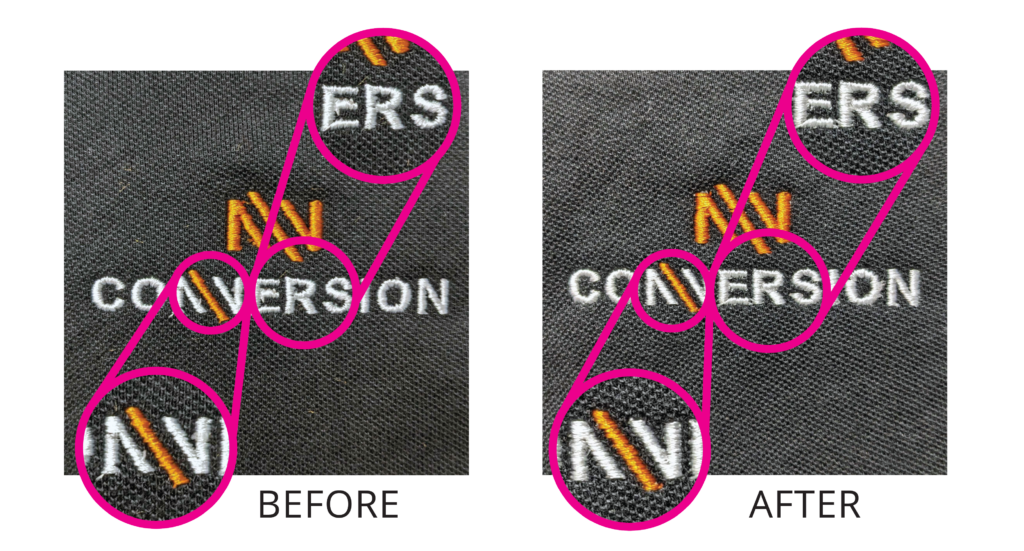Solving Problems with Solvy
When you decided to become an embroiderer, did you sit back and think of all the fun projects you could do for family and friends? Perhaps monogramming towels for a wedding or making a cute fuzzy blanket for a baby shower, only to find out it wasn’t as much fun as you thought. We’ve all been there—the towel or blanket material poking through your design, your embroidery not sewing as cleanly as you had hoped. Luckily, there is an easy solution to improve the outcome of your design when dealing with these troublesome fabrics.

Several sheets of different types of solvy.
In this article, we would like to introduce you to a remarkable stabilizer called water-soluble topping, or “solvy,” one of the embroidery world’s little gems that can take your designs to the next level. This essential material is a game changer for overcoming common challenges in the embroidery process. We would like to share with you some ways this thin soluble material has improved some of our projects, but first, let’s delve into what exactly water-soluble topping is.
A water-soluble topping is a thin layer of material that can be placed on top of your fabric during embroidery. Its purpose is to provide a smooth, texture-neutral surface for your machine’s needle to embroider thread. Once your design has finished stitching, simply tear away the excess solvy from your design, dampen a cloth, and use it to dissolve any additional solvy left behind.
So, what are some of the ways we can use this remarkable tool? For starters, water-soluble topping is invaluable when dealing with challenging fabrics like fuzzy materials, terry cloth, heavy fabrics similar to fleece, and knits such as pique.
Let’s begin with one of the most challenging fabrics to embroider on: fuzzy fabric! Have you ever tried embroidering on fluffy or textured fabric only to find that the thread doesn’t stand out as you hoped? Water-soluble topping is the solution you have been looking for. In the first design sample shown in the photos below, notice the variation in the design from our two sew-out examples and compare the design sewn on fluffy fabric using a solvy topping versus the same design on the same material without this stabilizing topping. In one photo, you can see where the pile gets unruly and sticks out between the stitches, but after using the topping, we have a neat and clean result without any stray fuzz in the design!

While towels are popular for embroiderers to personalize, terry cloth material behaves like fuzzy fabric and can be tamed with a sheet of solvy on top. Notice in the photos below how well the name “Jullian” embroiders with the use of solvy versus without it. The towel’s fibers stay behind the embroidered design, the columns look complete, and the edges of the text are clean. Give solvy a try the next time you customize a towel for a loved one!

Have you ever considered embroidering on fleece?
Fleece is another common fabric that poses the same difficulties as the previously mentioned textiles. Fleece pullovers are popular items for embroidery, but without proper measures, the threads from your design can easily get lost in the fabric. Adding this important stabilizer during your embroidery process can prevent this, ensuring a clean and beautiful design.

Please take a look at our embroidered samples on fleece. Using this solvy topping, we were able to flatten the fabric’s texture, providing a smooth surface for the needle to travel and penetrate through, ensuring the stitches hold together as digitized. This technique helps prevent these fibers in the fabric from peeking through the stitches.

Finally, we would like to discuss a more common fabric used for embroidery called pique. Woven fabrics like pique pose another challenge, as the fibers are not tightly woven. This may cause designs to appear thin once embroidered due to the movement of the fabric, manipulating the thread to move into the fibers, creating an appearance that differs from the digitized file. While it might not be obvious to use solvy with a material like pique, using this topping can elevate your projects that involve this challenging fabric.

A freestanding lace butterfly hooped with solvy as substrate
Check out our photo where no topping was used on this pique material. We see some inconsistencies between the letters and how the E and R could be clearer. The letters all seem to have a different baseline, and some columns sew out thinner than others. Here’s where water-soluble topping comes to the rescue. Notice how our second example embroidered on pique shows the importance of using solvy on this loosely woven material. The column widths are far more consistent, the letters sew out straight, and the spacing between the letters is more uniform. When paired alongside a digitized file created with lighter density, a topping like solvy ensures that your threads will not sink into the grooves of fabrics like pique, resulting in a more defined design.
Water-soluble toppings are not only used for preventative measures. One of our favorite “fun” projects to work on, which can add a certain niche to your business or impress some of your closest relations, is using solvy to create free-standing lace designs. Free-standing lace embroidery is a style of artistry that allows your design to appear as a lace design with no fabric behind it. In place of fabric used in traditional embroidery designs, solvy is used along with a specialized digitized file, allowing your design to stand beautifully free once the solvy is removed and the excess is washed away. If you want this delicate and dainty look, solvy is an absolute must!

A freestanding lace butterfly after the solvy has been dissolved with water and completely dried.
Whichever project you decide to work on, having a digitized design that works harmoniously with high-pile and textured fabrics is crucial for achieving fantastic embroidery results. Our team at PRO digitizing is here to help you every step of the way! If you have a project in mind that would benefit from using water-soluble topping but need help knowing where to start, feel free to reach out to our team at PRO digitizing. We’ll guide you in providing a high-quality digitized file and offer valuable suggestions to bring your project to life.
Water-soluble topping is an indispensable addition to any embroiderer’s toolkit, guaranteeing professional-level finishes. If you haven’t experienced its magic yet, we encourage you to give it a shot and let us know how it has transformed your embroidery projects.
PRO TIP: Store properly! To maintain the quality of your water-soluble topping, store it in a cool and dry place, away from direct sunlight or extreme temperatures. This prevents it from deteriorating or losing its effectiveness. Visit our Instagram page @prodigitizing for more #prosewtips
